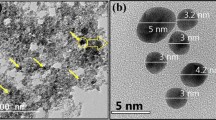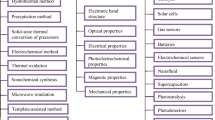Abstract
Graphite has attracted scientific interest due to its exceptional physical and chemical properties. On combustion, graphite particles offer high emissivity as a black body; therefore, it can find wide application in advanced decoy flares. Thermite particles (metal oxides/metal) can offer a high reaction temperature that is required to stimulate emitting species. In this study, graphite particles were employed with super-thermite Fe2O3 NPs. Novel Mg–Al bimetal alloy was employed as a reactive metal fuel; Viton A (fluorocarbon polymer) was employed as an energetic binder. Multi-component nanocomposite flares were developed via granulation with subsequent pressing. The thermal signature was measured using the IR spectrometer. Nanocomposite flares based on 6 wt% graphite and 2% Fe2O3 NPs demonstrated superior spectral intensity. This flare formulation offered an increase in average intensity by 248% to reference formulation. It offered the highest relative intensity value θ of 0.54. Graphite, as an allotrope of carbon, acts as an excellent source of carbonaceous materials that can strengthen incandescence emission.










Similar content being viewed by others
References
E.-C. Koch, Pyrotechnic countermeasures: II. Advanced aerial infrared countermeasures. Propellants Explos. Pyrotech. 31, 3–19 (2006)
E.-C. Koch, Metal-Fluorocarbon Based Energetic Materials (Wiley-VCH, Weinheim, 2012)
J. Andreotti, A. Hirschman, Infrared decoy method using polydimethylsiloxane fuel. Google Patents. https://patents.google.com/patent/US5343794A/en, 1994
S. Erwin, Anti-missile program for airliners on a Fast Track ‘Smart’ Flares being designed to defeat heat-seeking missiles, in National Defense, pp. 14–16. https://www.nationaldefensemagazine.org/article.cfm?Id=1281, 2003
T.M. Klapotke, C.M. Rienacker, Drophammer test investigations on some inorganic and organic azides. Propellants Explos. Pyrotech. 26, 43–47 (2001)
E.C. Koch, A. Hahma, V. Weiser, E. Roth, S. Knapp, Metal-fluorocarbon pyrolants. XIII: high performance infrared decoy flare compositions based on MgB2 and Mg2Si and Polytetrafluoroethylene/Viton®. Propellants Explos. Pyrotech. 37, 432–438 (2012)
V. Weiser, A. Blanc, L. Deimling, W. Eckl, N. Eisenreich, S. Kelzenberg et al., Pyroorganic flares—a new approach for aircraft protection, in Europyro 2007–34th International Pyrotechnics Seminar, vol. 1, pp. 8–11, 2007
M. Comet, V. Pichot, B. Siegert, F. Schnell, F. Ciszek, D. Spitzer, Phosphorus-based nanothermites: a new generation of energetic materials. J. Phys. Chem. Solids 71, 64–68 (2010)
L. Klusáček, P. Navratil, The use and application of red-phosphorous pyrotechnic composition for camouflage in the infrared region of radiation. Propellants Explos. Pyrotech. 22, 74–77 (1997)
E.C. Koch, S. Cudziło, Safer pyrotechnic obscurants based on phosphorus (V) nitride. Angew. Chem. Int. Ed. 55, 15439–15442 (2016)
E.-C. Koch, A. Dochnahl, Pyrotechnic active mass for producing an aerosol highly emissive in the infrared spectrum and impenetrable in the visible spectrum. Google Patents. https://patents.google.com/patent/US6581520B1/en, 2003.
N. Wardecki, S. Lauer, K. Hieke, Camouflage and decoy munitions for protecting objects against guided missiles. Google Patents. https://patents.google.com/patent/US20090301336A1/en, 2006.
E.C. Koch, A. Hahma, Metal-fluorocarbon pyrolants. XIV: high density-high performance decoy flare compositions based on ytterbium/polytetrafluoroethylene/Viton®. Z. Anorg. Allg. Chem. 638, 721–724 (2012)
E.-C. Koch, Pyrotechnic composition for producing IR-radiation. Google Patents. https://patents.google.com/patent/US6635130B2/en, 2009.
E.C. Koch, 2006–2008 Annual review on aerial infrared decoy flares. Propellants Explos. Pyrotech. 34, 6–12 (2009)
E.C. Koch, Metal–fluorocarbon pyrolants: X. Influence of ferric oxide/silicon additive on burn rate and radiometric performance of magnesium/Teflon/Viton® (MTV). Propellants Explos Pyrotech 34, 472–474 (2009)
E. Koch, Metal-fluorocarbon pyrolants: VIII. Behaviour of burn rate and radiometric performance of two magnesium/Teflon/Viton (MTV) formulations upon addition of graphite. J. Pyrotech. 27, 38 (2008)
M.P. Nadler, Pyrotechnic pellet decoy method. Google Patents. https://patents.google.com/patent/US6675716B1/en, 2004.
M. Comet, C. Martin, F. Schnell, D. Spitzer, Nanothermite foams: from nanopowder to object. Chem. Eng. J. 316, 807–812 (2017)
S. Elbasuney, A. Elsaidy, M. Kassem, H. Tantawy, Infrared signature of novel super-thermite (Fe2O3/Mg) fluorocarbon nanocomposite for effective countermeasures of infrared seekers. J. Inorg. Organomet. Polym. Mater. 28, 1718–1727 (2018)
S. Elbasuney, A. Elsaidy, M. Kassem, H. Tantawy, R. Sadek, A. Fahd et al., Super-thermite (Al/Fe2O3) fluorocarbon nanocomposite with stimulated infrared thermal signature via extended primary combustion zones for effective countermeasures of infrared seekers. J. Inorg. Organomet. Polym. Mater. 28, 2231–2240 (2018)
J.A. Conkling, C. Mocella, Chemistry of Pyrotechnics: Basic Principles and Theory (CRC Press, Boca Raton, 2010)
E.C. Koch, Metal–fluorocarbon pyrolants: X. Influence of ferric oxide/silicon additive on burn rate and radiometric performance of magnesium/Teflon/Viton® (MTV). Propellants Explos. Pyrotech. 34, 472–474 (2009)
V.E. Zarko, A.A. Gromov, Energetic Nanomaterials: Synthesis, Characterization, and Application (Elsevier, Cambridge, 2016)
C. Wei, Q. Chen, C. Cheng, R. Liu, Q. Zhang, L. Zhang, Mesoporous nickel cobalt manganese sulfide yolk–shell hollow spheres for high-performance electrochemical energy storage. Inorg. Chem. Front. 6, 1851–1860 (2019)
C. Wei, N. Zhan, J. Tao, S. Pang, L. Zhang, C. Cheng et al., Synthesis of hierarchically porous NiCo2S4 core-shell hollow spheres via self-template route for high performance supercapacitors. Appl. Surf. Sci. 453, 288–296 (2018)
C. Wei, Q. Ru, X. Kang, H. Hou, C. Cheng, D. Zhang, Self-template synthesis of double shelled ZnS-NiS1.97 hollow spheres for electrochemical energy storage. Appl. Surf. Sci. 435, 993–1001 (2018)
C. Wei, R. Zhang, X. Zheng, Q. Ru, Q. Chen, C. Cui et al., Hierarchical porous NiCo2O4/CeO2 hybrid materials for high performance supercapacitors. Inorg. Chem. Front. 5, 3126–3134 (2018)
A. Bouvy, A. Opstaele (eds.), Waterbrone Coating and Additives (Royal Chemical Society, London, 1995), pp. 180–189
S. Voyutsky (ed.), Colloid Chemistry (Mir Publishers, Moscow, 1978)
R.J. Hunter (ed.), Zeta Potential in Colloid Science (Academic Press, New York, 1981)
S. Elbasuney, M.G. Zaky, M. Radwan, S.F. Mostafa, Stabilized super-thermite colloids: a new generation of advanced highly energetic materials. Appl. Surf. Sci. 419, 328–336 (2017)
S. Elbasuney, Sustainable steric stabilization of colloidal titania nanoparticles. Appl. Surf. Sci. 409, 438–447 (2017)
S. Elbasuney, Dispersion characteristics of dry and colloidal nano-titania into epoxy resin. Powder Technol. 268, 158–164 (2014)
A.N. Popova, Crystallographic analysis of graphite by X-ray diffraction. Coke Chem. 60, 361–365 (2017)
Y. Mizutani, E. Ihara, T. Abe, M. Asano, T. Harada, Z. Ogumi et al., Preparation of alkali metal graphite intercalation compounds in organic solvents. J. Phys. Chem. Solids 57, 799–803 (1996)
XRD and Raman studies, M. J. I, V. M, C. P, and B. N, Augmentation of graphite purity from mineral resources and enhancing % graphitization using microwave irradiation. Diamond Relat. Mater. 88, 129–136 (2018)
G. Sun, X. Li, Y. Qu, X. Wang, H. Yan, Y. Zhang, Preparation and characterization of graphite nanosheets from detonation technique. Mater. Lett. 62, 703–706 (2008)
M.S. Asl, B. Nayebi, A. Motallebzadeh, M. Shokouhimehr, Nanoindentation and nanostructural characterization of ZrB2–SiC composite doped with graphite nano-flakes. Composites Part B Eng. 175, 107153 (2019)
K. Yoshida, Y. Sugawara, M. Saitoh, K. Matsumoto, R. Hagiwara, Y. Matsuo et al., Microscopic characterization of the C–F bonds in fluorine–graphite intercalation compounds. J. Power Sources 445, 227320 (2020)
P. Rzeczkowski, B. Krause, P. Pötschke, Characterization of highly filled PP/graphite composites for adhesive joining in fuel cell applications. Polymers 11, 462 (2019)
K.K. Alaneme, A.V. Fajemisin, N.B. Maledi, Development of aluminium-based composites reinforced with steel and graphite particles: structural, mechanical and wear characterization. J. Mater. Res. Technol. 8, 670–682 (2019)
E. Lorenzo-Bonet, M. Hernandez-Rodriguez, O. Perez-Acosta, M. De la Garza-Ramos, G. Contreras-Hernandez, A. Juarez-Hernandez, Characterization and tribological analysis of graphite/ultrahigh molecular weight polyethylene nanocomposite films. Wear 426, 195–203 (2019)
V.C. Karade, S.B. Parit, V.V. Dawkar, R.S. Devan, R.J. Choudhary, V.V. Kedge et al., A green approach for the synthesis of α-Fe2O3 nanoparticles from Gardenia resinifera plant and it's In vitro hyperthermia application. Heliyon 5, e02044 (2019)
D.E. Fouad, C. Zhang, H. El-Didamony, L. Yingnan, T.D. Mekuria, A.H. Shah, Improved size, morphology and crystallinity of hematite (α-Fe2O3) nanoparticles synthesized via the precipitation route using ferric sulfate precursor. Results Phys. 12, 1253–1261 (2019)
M. Sharma, α-Fe2O3 preparation by sol-gel method, pp. 1–16, 2017, https://bragitoff.com.
T. Liang, X. Guo, B. Yuan, S. Kong, H. Huang, D. Fu et al., Design of functionalized α-Fe2O3 (III) films with long-term anti-wetting properties. Ceram. Int. 46(5), 6129–6135 (2020)
M. Tadic, M. Panjan, B.V. Tadic, J. Lazovic, V. Damnjanovic, M. Kopani et al., Magnetic properties of hematite (α-Fe2O3) nanoparticles synthesized by sol-gel synthesis method: The influence of particle size and particle size distribution. J. Electr. Eng. 70, 71–76 (2019)
Q.Z. Zeng, S.Y. Ma, W.X. Jin, H.M. Yang, H. Chen, Q. Ge et al., Hydrothermal synthesis of monodisperse α-Fe2O3 hollow microspheroids and their high gas-sensing properties. J. Alloys Compd. 705, 427–437 (2017)
A. Ashour, A.I. El-Batal, M.A. Maksoud, G.S. El-Sayyad, S. Labib, E. Abdeltwab et al., Antimicrobial activity of metal-substituted cobalt ferrite nanoparticles synthesized by sol–gel technique. Particuology 40, 141–151 (2018)
M.A. Maksoud, G.S. El-Sayyad, A. Ashour, A.I. El-Batal, M.S. Abd-Elmonem, H.A. Hendawy et al., Synthesis and characterization of metals-substituted cobalt ferrite [MxCo(1–x)Fe2O4; (M = Zn, Cu and Mn; x = 0 and 0.5)] nanoparticles as antimicrobial agents and sensors for Anagrelide determination in biological samples. Mater. Sci. Eng. C 92, 644–656 (2018)
B. Coffey, D.R. Schropp Jr., K.C. Kwiatkowski, Solid-state thermite composition based heating device. Google Patents. https://patents.google.com/patent/US8864924B2/en, 2014.
M. Sjöberg, J.E. Dec, Smoothing HCCI heat-release rates using partial fuel stratification with two-stage ignition fuels. J. Engines 115(3), 318–334 (2006)
J.P. Longwell, M.A. Weiss, High temperature reaction rates in hydrocarbon combustion. Ind. Eng. Chem. 47, 1634–1643 (1955)
L. Allamandola, A. Tielens, J. Barker, Interstellar polycyclic aromatic hydrocarbons—the infrared emission bands, the excitation/emission mechanism, and the astrophysical implications. Astrophys. J. Suppl. Ser. 71, 733–775 (1989)
Funding
Not applicable.
Author information
Authors and Affiliations
Corresponding authors
Ethics declarations
Conflict of interest
The authors declare that they have no conflict of interest.
Additional information
Publisher's Note
Springer Nature remains neutral with regard to jurisdictional claims in published maps and institutional affiliations.
Rights and permissions
About this article
Cite this article
Elbasuney, S., Elmotaz, A.A., Sadek, M.A. et al. Novel nanocomposite decoy flare based on super-thermite and graphite particles. J Mater Sci: Mater Electron 31, 6130–6139 (2020). https://doi.org/10.1007/s10854-020-03166-4
Received:
Accepted:
Published:
Issue Date:
DOI: https://doi.org/10.1007/s10854-020-03166-4




